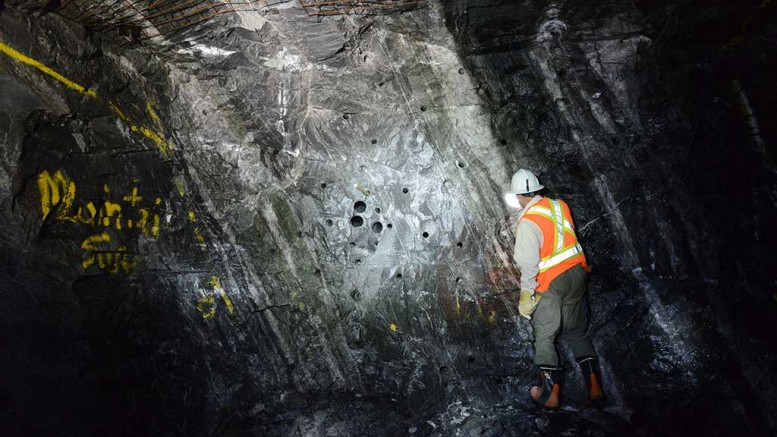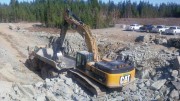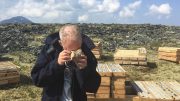Ontario is a hot spot for gold exploration in Canada, as it hosts several of the country’s large historic gold camps. According to Fraser Institute’s annual Survey of Mining Companies 2016, Ontario ranked as the sixth best jurisdiction for investment attractiveness in Canada and globally came in eighteenth place. Here’s a review of four gold projects in Ontario set to start production within the next two years:
Clavos
Sage Gold (TSXV: SGX) is lining up to become the newest producer in Timmins, Ont., with first production at its wholly owned Clavos gold deposit expected later this year.
“We are hoping at the end of September to start shipping mineralized material to the mill,” Sage’s CEO Nigel Lees says, adding that commercial production should begin in the first half of 2018.
Before commercial production kicks off, Sage plans to complete dewatering and rehabilitating the former mine by year-end, update the resource estimate and finish a prefeasibility study.
Sage has recently wrapped up 2,900 metres of surface drilling, which established a mineralized corridor between Clavos’ main mine zone and the 960 zone. It now aims to finish 9,200 metres of definition and exploration drilling from underground.
Based on a 2012 resource estimate of 316,000 indicated and inferred oz., a 2013 preliminary economic assessment (PEA) envisioned Clavos — permitted as a 700-tonne-per-day operation — cranking out a total 145,448 oz. over seven years.

The entrance culvert at Sage Gold’s past-producing Clavos gold project in northern Ontario’s Timmins camp. Credit: Sage Gold.
While estimated total capital was $35 million, including $8 million in start-up costs, both amounts have since gone down, largely because of the increase in the Canadian gold price, Lees says.
Development costs are low because the project benefits from over $60 million in historic investments and does not require building a mill. Sage will use Primero Mining’s (TSX: P) Black Fox-Stock mill, located 10 km away, on a toll-milling basis.
Sage closed an $11.5-million financing — including a $1.9-million equity raise and a $9.7-million gold prepayment facility with Cartesian Royalty Holdings — last November. Since then, it raised another $1.4 million in equity. The firm has $8 million on hand and should draw down the final $3.3-million tranche of the gold prepayment facility shortly, Lees says.

A truck loaded with development ore from Harte Gold’s Sugar gold deposit in northern Ontario. Credit: Harte Gold.
Sugar Zone
Harte Gold (TSX: HRT) is running to the finish line at its Sugar Zone property in White River, Ont., near the Hemlo gold camp. Harte expects to operate Sugar Zone as a 540-tonne-per-day underground operation, producing 50,000 oz. gold a year, over an initial eight-year mine life.
Construction on-site is set to start mid-year. The junior intends to begin mill commissioning in the first quarter of 2018, with commercial production starting at the end of the second quarter of 2018, Harte’s CEO Stephen Roman notes.
According to a 2012 PEA, Sugar Zone contains an indicated resource of 980,900 tonnes at 10.13 grams gold for 319,280 oz. (uncapped), and an inferred resource of 580,500 tonnes at 8.36 grams gold for 155,960 ounces (uncapped).
The junior will table an updated technical report, including a revised resource and mine plan, in early 2018.
It recently completed a 70,000-tonne bulk sample program that it started in October 2015. The sample, processed at Barrick Gold’s (TSX: ABX; NYSE: ABX) nearby Hemlo mill, generated $27.7 million in proceeds. During commercial production, Harte will process ore at its own mill. It anticipates receiving the commercial production permits in the third quarter of 2017.
Harte has launched an aggressive $15-million, 75,000-metre drill program to infill the Sugar Zone deposit and drill the nearby Middle and Wolf zones, with the aim of increasing the overall mine resource.
It is planning regional exploration on the now 800 sq. km Sugar Zone property, “where we expect to make discoveries, which could result in additional mines being developed,” Roman says.

A sign at Gowest Gold’s North Timmins Gold project in Timmins, Ont. Credit: GoWest.
Bradshaw
Gowest Gold (TSXV: GWA) has kicked off an advanced exploration program at its flagship Bradshaw gold deposit on its North Timmins gold project in Timmins, with commercial production set to start in less than two years.
The program, comprising a 30,000-tonne bulk sample containing 10,000 oz. gold, should wrap up in “the first half, possibly the first quarter of calendar 2018,” Gowest’s manager of investor relations Greg Taylor says. Gowest is preparing the area for the underground sample, with ore extraction expected this autumn.
Bradshaw’s advanced exploration work is funded by a definitive prepaid forward gold-purchase agreement that Gowest signed last December with Pandion Mine Finance. Under the agreement, the New York-based firm will pay Gowest US$17.6 million in four tranches over 12 months, as a partial consideration to buy up to 65,805 oz. gold from Bradshaw. Gowest has 27 months before it needs to deliver gold, following first tranche, received this February.
While Gowest has the permit for the bulk sample, Taylor notes it still needs to obtain a mining permit, sign impact and benefit agreements with First Nations, and finalize the joint-venture agreement with Northern Sun Mining (TSXV: NSC) to co-own the nearby Redstone mill, where it will process Bradshaw’s ore.
Taylor projects Bradshaw could reach commercial production in late 2018 or early 2019. An amended 2015 prefeasibility study envisions Bradshaw could produce a total of 305,058 oz. gold, including the bulk sample, over eight years. The estimated initial project cost is US$26.9 million, including US$10.7 million for the bulk sample.
Borden
The Borden underground project near Chapleau, Ont., is on track to become Goldcorp’s (TSX: G; NYSE: GG) next Canadian gold mine, with first production beginning in late 2019. Goldcorp bought the high-grade deposit, known as one of the best recent discoveries in Ontario, in a $526-million, all-stock takeover of Probe Mines in 2015. Borden sits 160 km west of Goldcorp’s long-operating Porcupine mine and milling facility. The major is prepping to build an underground ramp into the Borden deposit to extract a 30,000-tonne bulk sample. The ramp will encourage exploration drilling as well as mining.
After the bulk sample, Goldcorp intends to publish a feasibility study at the end of March 2019, where it would include Porcupine’s mill and infrastructure for processing. Goldcorp says that given the little infrastructure required for full-scale mining, Borden should reach commercial production six months after the bulk-sample extraction, which it expects will occur by the fourth quarter of 2019.
As of June 2016, Borden had gold reserves of 4.12 million tonnes grading 7.14 grams gold per tonne for 950,000 ounces. It had another 3 million tonnes of 5.77 grams gold for 560,000 oz. in measured and indicated.






Be the first to comment on "Ontario snapshot: Four gold projects nearing production"